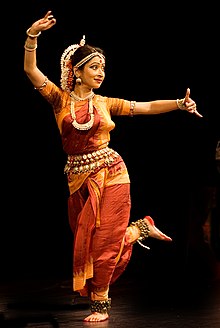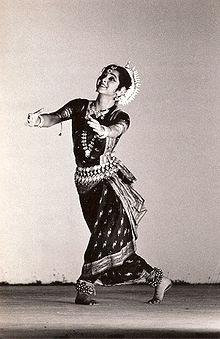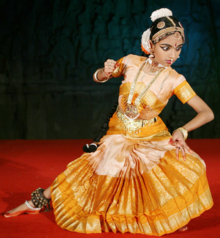Odissi





Odissi dance also known as Orissi (Oriya: ଓଡ଼ିଶୀ oṛiśī), is one of the eight classical dance forms of India. Its origin is traced to the state of Orissa in eastern India. It is the oldest surviving dance form of India on the basis of archaeological evidences. The classic treatise of Indian dance, Natya Shastra, refers to it as Odra-Magadhi. First century BCE bas-reliefs in the hills of Udaygiri (near Bhubaneswar) testify to its antiquity. It was suppressed under the British Raj, but has been revitalised since India gained independence. It is particularly distinguished from other classical Indian dance forms by the importance it places upon the Tribhangi (literally: three parts break), the independent movement of head, chest and pelvis and upon the basic square stance known as Chauka or Chouka that symbolises Lord Jagannath. on 23 December 2011, an Odissi performance was held with by 555 dancers both boys and girls from five countries participated. This was held at Kalinga Stadium which lasted for 28 minutes. This has been recorded in the Guinness Book of World Records.
Quotes
[edit]- Odisha located on the eastern sea coast of India is a place where the highly lyrical form of Odissi has evolved. On the temple walls of Bhubaneshwar, Konark and Puri, the Odissi dance sculptures are clearly evident. This dance style combines both Tandava and Lasya. Odissi has become as a classical dance form only in the last 60 years, but one can trace the dance style that prevailed in the region of Odisha and Bihar in the days of the Natya Shastra.
- In Shubhada Varadkar (30 August 2012). The Glimpse of Indian Classical Dance. Krimiga Books, Krimiga Content Development Pvt. Ltd.. pp. 54–55. ISBN 978-81-925709-0-7.
- Odissi and sacred arts in general can be compared with the great rivers like the Ganges. They have flown for ages absorbing and discarding in the process. There is invincible power in this great tradition to flow into the future through every threat, very much like the rivers do. However, like nature, even art forms need conscious effort from mankind to survive. It is important that these old traditions speak to the new generations and the latter relates to them instead of thinking of them as boring or uncool.
- By Bijayini Satpathy in "A Leap of Faith in Odissi’s Journey". New Indian Express. 8 December 2013. Retrieved on 16 January 2014.
- The Natya Shastra, an ancient text on dance and drama, written by Bharata Muni has mentioned four styles of classical dance prevalent in different parts of India; they are Avanti, Daksinatya, Panchali, and Audra Magadhi. Audra here refers to Odisha. Another text Abhinay Chandrika, stated that there were schools of dancing in India; one amongst them was Audra belonging to Odisha.
- In "The Glimpse of Indian Classical Dance}, p. 55.
- Odissi traces its origins to the ritual dances performed in the temples of ancient northern India. Today the name Odissi refers to the dance style of the state of Orissa in eastern India.
- By Anjana Rajan in Odissi. Retrieved on 13 January 2014.
- It was practiced in the most important shrines of the region, like that of Puri, as part of the ritual ceremonies since the year 1000, although it is believed that it existed from as far back as 200 BC.
- In Clive Barker; Simon Trussler (November 1998). New Theatre Quarterly 55. Cambridge University Press. pp. 249–. ISBN 978-0-521-64851-6.
- With the decline of Odissi dance and the culture of Orissa this saying emerged ‘People who have little shame sing, people with no shame play musical instruments, and those who are totally shameless, dance
- Quoted in "New Theatre Quarterly 55".
- The current form of Odissi is the product of a 20th century revival.
- By Anjana Rajan in "Odissi".
- When one speaks of the culture of Orissa the mention of Orissi dance becomes a natural thing to do. And when one speaks of the Odissi dance, a mention of the great Sanskrit poet Jayadeva, who wrote the Gita Govinda becomes a must.
- By Manohar Sajnani in Manohar Sajnani (2001). Encyclopaedia of Tourism Resources in India. Gyan Publishing House. pp. 260–. ISBN 978-81-7835-018-9.
- It is a classical dance, danced mostly by women...It originated in the temples where the composers, singers, and the dancers came together. It centered on the celestial love of Krishna and Radha. At one time it was performed by the Devadasis dedicated to the temples but now it has spread out to the homes and cultural institutions. But the purity is maintained and the essentials are always kept in view.
- By Manohar Sajnani in "Encyclopaedia of Tourism Resources in India".
- The Odissi dance of Odisha (Orissa) is one of the six acknowledged classical dance forms of India. Like all other Indian classical dances, it also has its initiation in religion and philosophy with an origin in the temples of Odisha (Orissa). The rhythm, Bhangis and Mudras used in Odissi dance have a distinct style of its own. The dance is performed mainly with the theme of Infinite love of Lord Krishna and Radha.
- In Odissi Dance. Official web site of Orissa Tourism. Retrieved on 13 January 2014.
- Being a part of the culture and knowing the language are very essential for any Indian classical dance. For Odissi, you need to read, write and speak Oriya. You also need to understand Odissi classical music, Sanskrit, myths and epics in Hinduism. You must experience Jagannath culture, be familiar with Orissa's history, its legends and myths. You must be able to immerse completely in the local culture to be a good dancer.
- By Shibani Patnaik in "Joy of Odissi". The Hindu. 25 February. Retrieved on 14 January 2014.
- Odissi dance lives on in the ancient temple sculptures and friezes of the State of Orissa on the eastern coast of India. Neglected in this century, it has been less well known and less practiced than Bharata Natyam.
- By Jennifer Dunning in "Review/Dance; The Ancient Odissi Style Steps Off an Indian Frieze". New York Times. 26 March 1988. Retrieved on 13 January 2014.

- The dance experience is an interface between person and culture.
- By Snyder in the article “Transformation, inner space and future of Dance" quoted in Smritilekha Nayak (2008). Dance and Architecture: Body, Form, Space and Transformation. ProQuest. pp. 25–. ISBN 978-0-549-96518-3.
- The Konarak temple represents the period when dance and architecture reached a point of climax in history and followed a sharp decline when Islam and later colonialism affected the culture and arts due to the changing religious and political scene of the state. Odissi dancers in the temples were considered prostitutes and when British rule came in to effect the performance of Odissi as a religious ritual was completely banned from the temple. For 200 years Odissi dance faced the most draw back until it was in the 1950s when the country was in the process of regaining its national identity after its independence in 1947.
- In "Dance and Architecture: Body, Form, Space and Transformation", p. 25.
- The community which played the greatest role in popularizing this art--by giving it a news spirit, a new hope and horizon--was the community of the temple maidens or Devadasis. Devadasis or Maharis used to practice this dance form and used to perform it before the lord as a form of prayer or ritual. At first, only some Mantras accompanied their Nrutya. But after Jayadev composed the Geeta Govindam, thus incorporating abhinaya in dance form, the grace of this dance form got revived.
- In "Dance and Architecture: Body, Form, Space and Transformation", p. 25.
- The new form of Odissi had its old historic roots yet it had changed to conform to the changing cultural trends of the people during the 1950s-60s. Earlier it was bound within the religious doors of the Hindu temples but upon its revival it became a more public or secular form of art and was performed on stage world wide.
- In "Dance and Architecture: Body, Form, Space and Transformation", p. 25.
- When the dancers had only the static sculptures of the temples to recreate Odissi, their task was to design the movement from stance A to stance B in a way designing the in-between space or the transition from one gesture to another, which can be likened to the process of moving through a temple or going down a stepped well and experiencing the different threshold to reach the destination.
- In "Dance and Architecture: Body, Form, Space and Transformation", p. 25.
- Indeed, the Odissi seen today is the result of a continuous life long effort made by some Gurus and dancers of Orissa.
- In Link. United India Periodicals. 1986.
- Samjukta Panigrahi along with her guru Kelucharan Mahapatra, is credited with reviving the all but extinct Odissi dance, an ancient Indian performance form from Orissa state. Odissi is solo form that combines music, song and a style of dance that includes a rich choreography with mudra hand gestures similar to those in other Indian genres such as Kathakali and pantomimic movement to convey complex narratives of love, personnel sacrifice and humankind’s relations to the gods.
- In Ian Watson (11 October 2002). Negotiating Cultures: Eugenio Barba and the Intercultural Debate. Manchester University Press. pp. 67–. ISBN 978-0-7190-6170-7.
- The Odissi dancer Samjukta Panigrahi...carried the heritage of an ancient art form revived in her body. Her artistry was based on the teaching of her guru Kelucharan Mahapatra, her ability to give physical form to the ancient carvings of temple of temple dancers on the walls of the temples in Orissa, and the transformation of the Natyashstra’s performance rules into the odissi dance form.
- In "Negotiating Cultures: Eugenio Barba and the Intercultural Debate".
- Odissi dancers use their heads, busts, and torsos in soft flowing movements to express specific moods and emotions.
- In Raymond S. T. Lee; Vincenzo Loia (1 January 2007). Computational Intelligence for Agent-based Systems. Springer. pp. 239–. ISBN 978-3-540-73177-1.
- In Indian Odissi dance, the performers’ body must be curved like a ‘S’ which passes through the head, shoulders and head. The principle of thribhangi sinuosity is clearly visible in all classical Indian statues…
- By Eugenio Barba in Eugenio Barba (9 March 2004). The Paper Canoe: A Guide to Theatre Anthropology. Routledge. p. 18. ISBN 978-0-203-36009-5.
- All the technique of the dance is based on a division of the body into two equal halves according to a vertical line which passes through it , ad on the unequal distribution of weight, some times more on one half of the body, some times more on the other half.
- By Samjukta Panigrahi in "The Paper Canoe: A Guide to Theatre Anthropology", p. 22

- Odissi is the only dance today in which practicing artist still use the term [bandha] to mean a separate follow the strictest egory of dance sequence. These follow the strictest possible rules of movements, some time producing acrobatic postures.
- By Jonathan Katz in Jonathan Katz (1992). The Traditional Indian Theory and Practice of Music and Dance. BRILL. pp. 218–. ISBN 90-04-09715-5.
- When we compare the bandhanrtta found in Nartananirnaya with the bandhanrtta practiced in the Odissi style, we find striking similarities. The bandhanrtta of Nartananirnaya requires combination created out of a base of sixteen karanas or short dance sequences, the bandhanrtta of Odissi requires seventeen. These karanas are extremely difficult to perform because of the physically demanding nature of their constituent movements and their rigorous design. As a result they are not commonly practiced.
- By Jonathan Katz in "The Traditional Indian Theory and Practice of Music and Dance" p. 218.
- We want to dance, we love the Indian dance because it gives joy, but we must remember that there should be integrity and reverence.
- By Rukmini Devi Arundale quoted in Clive Barker; Simon Trussler (November 1998). New Theatre Quarterly 55. Cambridge University Press. pp. 249–. ISBN 978-0-521-64851-6., p. 257.
- Straight lines don’t exists in Odissi. In contrast to the other classical Indian dances…take the position of tribhangi, the characteristic position of the Odissi style, made from three curves of the body with the torso displaced in the opposite direction to that of the waist and the head.
- By Samjukta Panigrahi quoted in "New Theatre Quarterly 55", p. 257.
Grammar of Odissi
[edit]
- Odissi has emerged as a sculpturesque dance in which the head, bust and torso move in soft flowing movements to express specific moods and emotions.
- In Aakriti Sinha (2006). Let's Know Dances of India. Star Publications. pp. 15–. ISBN 978-81-7650-097-5.
- After the exercise of the feet and the legs, the head and eyes, one learned the hand gestures, the mudras or hastas. There are 28 basic gestures for one hand and 24 basic gestures for both the hands....Each hand gesture has its own use.
- By Samjukta Panigrahi quoted in "New Theatre Quarterly 55". p. 258
- [That we learn] 15 types of jumps and 15 types of pirouettes and the four basic body positions on which the style is based, and 36 foot positions. Each position, gesture, or movement has its own technical name...
- By Samjukta Panigrahi quoted in "New Theatre Quarterly 55", p. 258
- Then there are the different ways of walking. [We have] sixteen types of walks – for example like a warrior, a lady, a man…learn many animal and bird movements.
- By Samjukta Panigrahi quoted in "New Theatre Quarterly 55", in p. 258

- In the Odissi syle [we have] many different steps in the basic position called chauka, which means square, and the same amount in the position called tribhanghi, when the body assume three curves.
- By Samjukta Panigrahi quoted in "New Theatre Quarterly 55", p. 258
- The steps are practices according to the rhythm
- By Samjukta Panigrahi quoted in "New Theatre Quarterly 55", p. 258
- There are four movements of the torso: deflecting to the left, to the right, in, and out, and the fifth is around in a circle.
- By Samjukta Panigrahi quoted in P.259
- We have nine major sentiments…. The nine universally known emotions are sringara (love), vira (heroism), karuna (pathos), adbhuta (wonder), raudra (anger), hasya (humour), bhyanaka (fear), bibhatsa (disgust) and shanta (peace).
- By Samjukta Panigrahi quoted in "New Theatre Quarterly 55", p. 259
- To show love, [you are taught] to flicker the eyes and this flickering is executed differently depending on the character
- By Samjukta Panigrahi quoted in "New Theatre Quarterly 55", p. 259.
- There are two types of expression: the loka dharma and the natya dharma. Loka dharma is very natural, similar to the behavior of daily life, nitya dharma is an idealized behavior that is used in dance....one were a realistic behavior and the other stylized, saying that Indian art has always favoured idealism on stage.
- By Samjukta Panigrahi quoted in "New Theatre Quarterly 55", p. 259.
- After having learned all the elements of the dance and the nine emotions, once the technique is mastered [we must] continue to practice it so as not to worry about it when we are on stage dancing.
- By Samjukta Panigrahi quoted in "New Theatre Quarterly 55", p. 259.
- Like all dances of classical nature, the Odissi is also accompanied by singing in which people specialize and the compositions of Jayadeva and other poets are utilized for the purpose. In fact, the Oriya style of singing and the rendering of the poet’s songs is somewhat distinct and this has given birth to a style of some ragas and musical performance which are unique and special to Orissa.
- By Manohar Sajnani in "Encyclopaedia of Tourism Resources in India".
- Odissi dance has gained acceptance as a classical form while the Centre is expected to accord similar status to Odia soon. Odissi music too has been claiming such a tag since long.
- In "Odissi music must get classical tag: Ramahari Das". Tines of India. 2 August 2013. Retrieved on 12 January 2014.
- Indeed, the Odissi seen today is the result of a continuous life long effort made by some Gurus and dancers of Orissa.
- In Link. United India Periodicals. 1986.
Poem
[edit]
- By the dew drop of Celestine dawn though saw a dream
Like a shining star of the Milky Way, I rest on the stream
Thy circular flow is constant rhythm of my fight
Your ancient stone is timeless flora of thy sight
Fortunate to behold the lord of the world so near
You never know when and how you are his dear
Divinity all over from sand lowest to peak highest
Faith in the tinkling bells never moved slightest
As essence of his kingdom’s innermost purity
Blessed to worship the brightest in darkest sanctuary.- A poem on Odissi in "The Glimpse of Indian Classical Dance", p. 54.
External links
[edit]- Aakriti Sinha (2006). Let's Know Dances of India. Star Publications. pp. 15–. ISBN 978-81-7650-097-5.
- "Odissi performance in Guinness record". Times of India. 23 January 2012. Retrieved on 13 January 2014.
- Eugenio Barba; Professor Eugenio Barba; Nicola Savarese (18 March 2011). A Dictionary of Theatre Anthropology: The Secret Art of the Performer. Taylor & Francis. pp. 129–. ISBN 978-1-135-17635-8.

